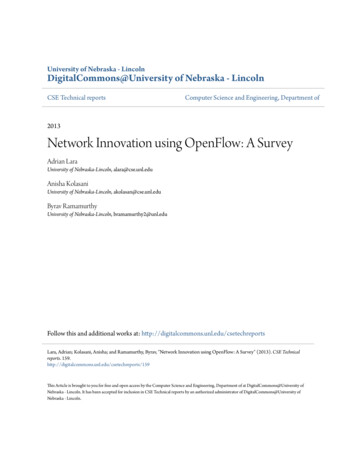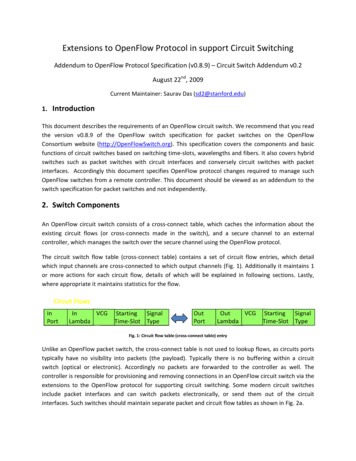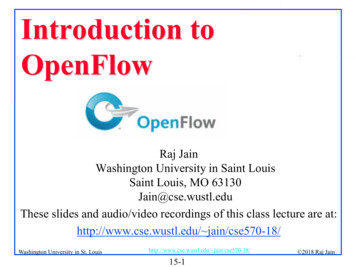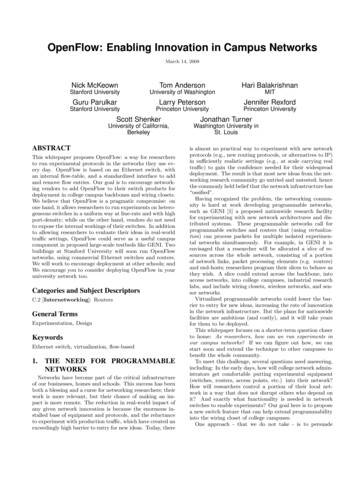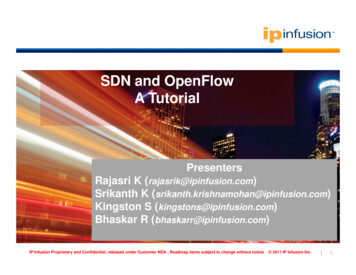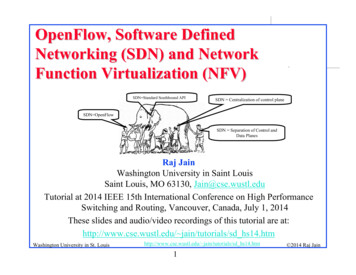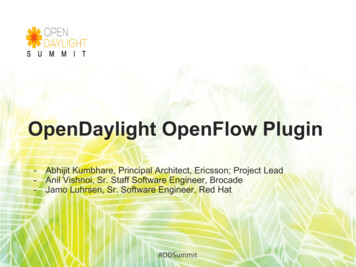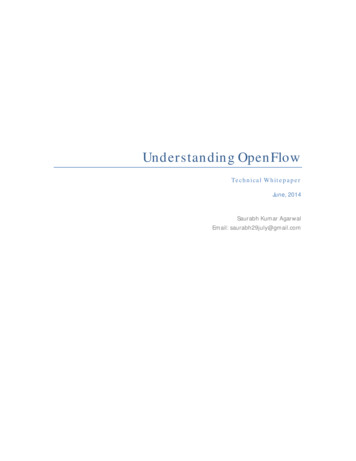
Transcription
Understanding OpenFlowTechnical WhitepaperJune, 2014Saurabh Kumar AgarwalEmail: saurabh29july@gmail.com
Understanding OpenFlow Technical WhitepaperAbstractTechnical overview of OpenFlow Switch Specification, Version 1.0.0, published on December31, 2009 by Open Networking Foundation.IntroductionOpenFlow protocol addresses the two key requirements needed to turn the concept of SDNinto practical implementation. First, there must be a common logical architecture in allnetwork devices to be managed by an SDN controller. Second, a standard, secure protocol isneeded between the SDN controller and the network device.OpenFlow is defined in the OpenFlow Switch Specification, published by the OpenNetworking Foundation (ONF). ONF is a consortium of software providers, contencontent deliverynetworks, and networking equipment vendors whose purpose is to promote SDN.This paper discusses the basic technical aspects of OpenFlow 1.0.0Traditional Vs. OpenFlow Based NetworksThere is a distinct difference between how switching happens in traditional networksand how OpenFlow proposes to change it. To further understand the concepts ofOpenFlow it is important to know this difference.Traditional SwitchingSwitching traditionally at L2 level has always been done using MAC addresses. EacEach devicemaintains its own MAC table based on which it learns where other devices are located.1.2.3.4.5.Client 1 sends data to Client 2Frame arrives at Switch A with MAC EEEE:EEEE:EEEE to MAC FFFF:FFFF:FFFFMAC address table is checked for location of MAC FFFF:FFFF:FFFFEntry is found in forwarding tableFrame is transmitted out of P2
Understanding OpenFlow Technical WhitepaperOpenFlow SwitchingSwitching in OpenFlow based networks is done using flows instead of MAC or IP tables. Eachflow entry has rules and actions corresponding to it. When the rule is satisfied, thecorresponding action is taken by device.Every flow in OpenFlow has three parts to it:1. Rule – This is what defines the flow and carries information for packet matching.2. Action – What you want switch to do on rule match? There are three actions thatOpenFlow supports:a. Forward – Forward to the output portb. Drop – Drop the packetsc. Redirect – Encapsulate the packet and redirect to SDN Controller.OpenFlow ComponentsAn SDN controller communicates with OpenFlow-compatibleOpenFlowdevices using the OpenFlowprotocol running over the Secure Sockets Layer (SSL). Each device connects to otherOpenFlow devices and, possibly, to end-userend user devices that are the sources and destinationsof packet flows. Within each device,device a series of tables—typicallylly implemented in hardwareor firmware—areare used to manage the flows of packets through the device.So the major two components of OpenFlow are, Flow Table and Secure Channel ProtocolProtocol.
Understanding OpenFlow Technical WhitepaperFlow TableThe basic building block of OpenFlow is the flow table. EEachach packet that enters a devicepasses through one or more flow tables. Flow tablethas following three things.Header FieldActionCountersHeader FieldEach flow table header entry is made up of six components, which defined the matchingrules and other basic rules for the corresponding flow.ActionEach flow entry is associated with zero or more actions that dictate how the device handlesmatching packets. Actions in OpenFlow specification are defined as required and optional.Optional actions aree not required to be implemented by vendors as such.
Understanding OpenFlow Technical WhitepaperCountersCounters are maintained per-table,table, per-flow,perper-portport and per queue. There are a set ofrequired counters that all the implementations should support and there are additionallyoptional counters.Flow Matching ExampleA sample packet flow matching flowchart is below explaining how the packet matching isdone with OpenFlow 1.0.0.
Understanding OpenFlow Technical WhitepaperSecure ChannelThe OpenFlow protocol describes message exchanges that take place between an OpenFlowcontroller and an OpenFlow device.device. Typically, the protocol is implemented on top of SSL orTransport Layer Security (TLS), providing a secure OpenFlow channel.The OpenFlow protocol enables the controller to perform add, update, and delete actions tothe flow entriess in the flow tables.tables It supports three types of messages:1. Controller-to-Device:: These messages are initiated by the controller and, in somecases, require a response from the device.2. Asynchronous: These types of messages are sent without solicitation from thecontroller.3. Symmetric: These messages are sent without solicitation from either the controlleror the device. They are simple yet helpful.Below is the list of complete OpenFlow messages thatthat any implementation needs tosupport.
Understanding OpenFlow Technical WhitepaperOpenFlow Communication ExampleBelow is a example of how OpenFlow communication is setup and maintained with a switchwhich is OpenFlow enabled.ReferencesOpen Networking FoundationOpenFlow 1.0.0 Specification
OpenFlow is defined in the OpenFlow Switch Specification, published by the Open Networking Foundation (ONF). ONF is a consortium of software providers, conten networks, and networking equipment vendors whose purpose is to promote SDN. This paper discusses the basic technical aspects of OpenFlow 1.0.0 Traditional Vs. OpenFlow Based
